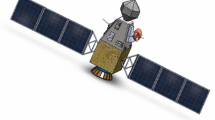Abstract
In this paper we consider the problem of optimal regulation of large space structures in the presence of flexible appendages. For simplicity of presentation, we consider a spacecraft consisting of a rigid bus and a flexible beam. The complete dynamics of the system is given by a coupled set of ordinary and partial differential equations. We show that the solution of this hybrid system is defined in a product space of appropriate finite- and infinite-dimensional spaces. We develop necessary conditions for determining the control torque and forces for optimal regulation of attitude maneuvers of the satellite along with simultaneous suppression of elastic vibrations of the flexible beam.
Similar content being viewed by others
References
N. U. Ahmed, Optimal control of generating policies in a power system governed by second-order hyperbolic partial differential equations,SIAM J. Control Optim.,15 (1977), 1016–1033.
N. U. Ahmed, Necessary conditions of optimality for a class of second-order hyperbolic systems with spatially dependent controls in the coefficients,J. Optim. Theory Appl.,38 (1982), 423–446.
N. U. Ahmed, Distributed parameter systems, inEncyclopedia of Physical Science and Technology, Vol. 4, pp. 362–385, Academic Press, New York, 1987.
N. U. Ahmed and K. L. Teo,Optimal Control of Distributed Parameter Systems, North-Holland, New York, 1981.
R. Araya, A controllability—stabilizability result for the SCOLE,Proceedings of the NASA SCOLE Workshop, Langley Research Center, Hampton, VA, December, 1984.
A. Arbel and N. K. Gupta, Robust colocated control for large flexible structures,J. Guidance and Control,4 (1981), 480–486.
A. V. Balakrishnan, A Mathematical Formulation of the SCOLE Control Problem, NASA Report NASA CR-17258, Langley Research Center, Hampton, VA, 1985.
S. K. Biswas and N. U. Ahmed, Modelling of flexible spacecraft and their stabilization,Internat. J. Systems Sci.,16 (1985), 535–551.
S. K. Biswas and N. U. Ahmed, Stabilization of a class of hybrid systems arising in flexible spacecraft,J. Optim. Theory Appl.,50 (1986) 83–108.
S. K. Biswas and R. D. Klafter, Dynamic modeling and optimal control of flexible robotic manipulators,Proceedings of the 1988 IEEE Conference on Robotics and Automation, Philadelphia, May 1988.
J. A. Breakwell, Optimal feedback slewing of flexible spacecraft,J. Guidance and Control,4 (1981), 472–479.
J. L. Lions,Optimal Control of Systems Governed by Partial Differential Equations, Springer-Verlag, Berlin, 1971.
J. L. Lions and E. Magenes,Non-Homogeneous Boundary Value Problems and Applications, Springer-Verlag, Berlin, 1972.
L. Meirovitch, Stability of a spinning body containing elastic parts via Lyapunov's direct method,AIAA J.,8 (1970), 1193–1200.
L. Meirovitch, A method of Lyapunov stability analysis of force-free dynamical systems,AIAA J.,9 (1971) 1695–1700.
L. Meirovitch, Modal-space control of large flexible spacecraft possessing ignorable coordinates,J. Guidance and Control,3 (1980), 569–577.
D. Schaechter, Optimal local control of flexible structures,J. Guidance and Control 4 (1981), 22–26.
S. B. Skaar, L. Tang, and I. Yalda-Moosabad, On-off control of flexible satellites,J. Guidance and Control,9 (1986), 507–510.
K. L. Teo and Z. S. Wu,Computational Methods for Optimizing Distributed Systems, Academic Press, New York, 1984.
A. Thowsen and W. R. Perkins, Observability conditions for a class of mixed distributed and lumped parameter systems,Automatica,12 (1976), 273–275.
J. D. Turner and H. M. Chun, Optimal distributed control of a flexible spacecraft during a large-angle maneuver,J. Guidance and Control,7 (1984), 257–264.
J. D. Turner and J. L. Junkins, Optimal large-angle single-axis rotational maneuver of flexible spacecraft,J. Guidance and Control,3 (1980), 578–585.
P. K. C. Wang, Control of distributed parameter systems, inAdvances in Control Systems Vol. 1 (C. T. Leondes, ed.), pp. 70–170, Academic Press, New York, 1964.
P. K. C. Wang, On the stability of equilibrium of a mixed distributed and lumped parameters control system,Internat. J. Control,3 (1966), 139–147.
Author information
Authors and Affiliations
Rights and permissions
About this article
Cite this article
Biswas, S.K., Ahmed, N.U. Optimal control of large space structures governed by a coupled system of ordinary and partial differential equations. Math. Control Signal Systems 2, 1–18 (1989). https://doi.org/10.1007/BF02551358
Received:
Revised:
Issue Date:
DOI: https://doi.org/10.1007/BF02551358




